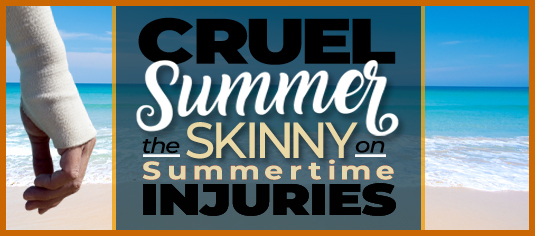Cruel Summer: The Skinny on Summertime Injuries
For most of us, summertime conjures up thoughts of warm days spent swimming at the beach or pool, adventuring outdoors, and creating special memories with family and friends. Along with all the fun in the sun, the risk of certain accidents and injuries also increases in summer.
From heat-related illnesses and hot car deaths to drownings, watercraft accidents, motor-vehicle collisions, and summer sports accidents, the summer season is ripe with opportunities for injury.
Every activity under the sun involves risk. The law firm of Carpenter & Zuckerman is standing by, ready to help you navigate the rough waters of the legal system if you sustain an injury this summer or any time of the year. Call (888) 484-2033 or contact us online today to receive a FREE consultation with one of our seasoned personal injury lawyers!
Hot Car Deaths and Heat-Related Illnesses
With July 3, 2023, setting a global record as the hottest day ever recorded, heat-related illnesses and hot car deaths are significant summertime threats to be aware of, particularly for children and vulnerable adults.
Between 1998 and 2023, over 950 U.S. children died from being left in a hot car. On average, 38 children die each year from pediatric vehicular heatstroke (PVH) in the U.S. These disturbing statistics, compiled by Jan Null of NoHeatStroke.org, demonstrate the vital importance of never leaving children, vulnerable adults, or pets unattended in vehicles.
Symptoms of heat stroke include excessive sweating, hot skin, dangerously high body temperature, mental confusion, impaired speech, unconsciousness, seizure, and death. It is important to note that although heat stroke can begin with heat rash and heat exhaustion symptoms, the symptoms of heat-related illnesses can occur suddenly, in any order — they do not always progress from mild to severe.
According to the Centers for Disease Control, the most common heat-related illnesses to be aware of, in descending order of severity, include:
- Heat stroke - The body loses the ability to regulate its temperature
- Heat exhaustion - Occurs when the body loses too much water & salt via sweating
- Rhabdomyolysis (rhabdo) - A rapid breakdown of muscle tissue from physical exertion
- Heat Syncope - Fainting episode triggered by dehydration and poor acclimation
- Heat cramps - Muscle cramps due to the loss of water & salt via excessive sweating
- Heat rash - Red, irritated skin caused by sweating during hot & humid weather
For more information, including the symptoms and treatments for heat-related illnesses, view the CDC’s flyer, First Aid for Heat Illness.
Motor Vehicle Accidents Heating Up With Summer
It’s a fact: car accidents increase in the summertime. According to National Safety Council (NSC) data, in 2021, the number of motor vehicle fatalities was highest during July, August, and October. This trend occurs because more cars are on the road during the summer. Vehicle miles traveled are directly correlated to motor-vehicle accident fatalities. The NSC states, “During the winter months, vehicle miles and deaths go down, while in the summer months, vehicle miles and deaths increase.”
Take the following steps to help prevent needless car accidents from impacting your summer travel plans:
- Perform necessary vehicle maintenance before your road trip.
- Check your tires before traveling, as poor tire condition contributes to accidents.
- Slow down! Speed was a factor in 1/3 of traffic fatalities over the last 2 decades.
- Prevent fatigue by making frequent stops along your travel route.
- Limit distractions from electronic devices, food, and people while driving.
- Use extra caution driving in summer traffic; watch for motorcyclists & bicyclists.
Accidental Drownings: The Silent Summertime Killer
Swimming is a beloved summer activity. Who doesn’t love beating the heat splashing around at the pool, beach, lake, or river? Still, the danger of drowning lurks just beneath the water’s surface, especially for children.
Most of us imagine drowning to be a loud, dramatic scene. However, the truth is that many drownings occur silently and go unnoticed until it’s too late, even when help is nearby. In fact, accidental drownings are most likely to happen when adults are present and assume others are supervising children, such as during a summer pool party.
Accidental drowning is the number one cause of death in children ages 0-4 and the second leading cause of unintentional injury death in children ages 5 to 14 in the United States, according to the Centers for Disease Control (CDC). Given these disturbing statistics, it is essential to understand the risks involved in swimming, recognize the signs of drowning, and know what to do if a swimmer needs help.
Common Warning Signs of Drowning
Look for these common, though often silent, signs that a swimmer is in distress:
Head tilted back in the water, with mouth open
Mouth just above the water line
Eyes glassy & unable to focus, or closed
Facedown, motionless in the water
Vertical in the water, but not moving limbs to tread water
Not moving forward in the water, i.e., caught in a rip current
Skin may appear blue from oxygen deprivation
Gasping for air, coughing, or hyperventilating
What to Do if Someone Is Drowning
If you suspect a swimmer is in distress, follow the steps below until help arrives:
Alert a lifeguard immediately, if one is present
Call 911 or ask a bystander to call
Provide a floatation device to the swimmer, if possible
Pull the swimmer out of the water, if you can safely help them
Begin CPR if the person is not breathing / does not have a pulse
Use an AED (automated external defibrillator), if available
It is crucial to exercise extreme caution when attempting to rescue a swimmer in distress. The potential drowning victim may be in a state of panic and could push a rescuer underwater in a desperate attempt to survive. Always use a floatation device if one is available.
Boating and Other Watercraft Accidents
With nearly 1,000 miles of coastline and plenty of lakes and reservoirs, California and Washington are prime recreational boating locations. Particularly in the summertime, when the water and air temperatures are warmer, boating is a popular pastime; however, it carries the risk of severe injury or death.
According to U.S. Coast Guard (USCG) Data, in 2022, there were 5.4 deaths per 100,000 registered recreational vessels and $63 million in property damage due to boating accidents. Many known factors contribute to the prevalence of boating and other watercraft accidents, including inadequate operator training, operator distraction, boating under the influence of alcohol, excessive speed, and mechanical or equipment failure.
The USCG recommends the following safety measures to prevent boating accidents:
Boat sober: Alcohol is the leading contributing factor in boating fatalities.
Take a boating safety course: Lack of operator training is another major factor in many boating accidents.
Wear a life jacket: 75% of all boating fatalities involve drownings. 85% of these drowning victims were not wearing life jackets.
Wear the engine cut-off switch: This allows fast engine shut-off if the operator is displaced or ejected from the helm.
Get a free safety vessel check before heading out on the water.
Bicycling Accidents and Summer Injuries
Bicycle accidents are prevalent during the summer when people spend more time outdoors enjoying the warmer weather and longer daylight hours. In 2021, 966 bicyclists died in traffic collisions. However, the risk of being involved in a fatal bicycle accident is highest from June to September, according to the National Highway Traffic Safety Administration (NHTSA).
Significant risk factors for bicycle accidents include:
Urban locations: Nearly 75% of bicycle accidents occur in urban areas.
Failure to yield: Most bicycle fatalities involve motorists failing to yield the right-of-way.
Lack of visibility: Many bike crashes occur due to inadequate lighting & reflective gear.
No helmets: Failure to don a helmet & other safety gear is a major factor in bicycle fatalities.
Alcohol: Alcohol use by either the motorist or bicyclist is a factor in nearly one-third of fatal bicycle crashes
Tips to Prevent Serious Bicycle Accidents
Although no accident is fully preventable, there are simple steps you can take to reduce your risk of being involved in a serious bicycle accident this summer. Follow these safety guidelines to help prevent a needless tragedy:
Always wear a helmet and other safety gear to lower your risk of serious injury.
Wear reflective clothing and equip your bicycle with reflectors & lights.
Avoid alcohol and drug use when bicycling, as this increases your risk of injury.
Make eye contact with motorists & yield when necessary, even if you have the right-of-way.
Follow all traffic laws and posted signs when cycling, particularly in urban areas.
Perform routine maintenance on your bicycle to ensure it is in good working order.
Remain alert and aware of your surroundings, paying attention to hazards on the road.
Summertime Injuries: Know the Facts So You Can Act
Knowing the facts about common summertime injuries and what steps you can take to prevent them is important. Use the helpful list below to learn simple steps you can take to avoid common summertime injuries:
Hot Car Deaths
FACT: On average, 38 children die annually in the U.S. from pediatric vehicular heatstroke.¹
ACT: Never leave a child or pet alone in a car, even for a short period of time.
Motor Vehicle Accidents
FACT: Motor-vehicle deaths increase in summer months when Americans drive more miles.²
ACT: Drive with extra caution, minimize distractions, and watch for pedestrians & cyclists.
Drownings
FACT: Drowning is the #1 cause of death for children ages 1-4 in the U.S.³
ACT: Designate a responsible adult to supervise children closely in or near water.
Boating Accidents
FACT: 633 people died in recreational boating accidents nationwide in 2022.⁴
ACT: Boat sober! Alcohol is the leading known contributing factor in boating fatalities.
Bicycling Accidents
FACT: Bicycle fatalities are highest between June to September in the U.S.⁵
ACT: Watch for cyclists! Failing to yield the right-of-way is the #1 factor in bicycle fatalities.
Heat-Related Illness
FACT: Almost all heat-related deaths occur between June to September in the U.S.⁶
ACT: Drink plenty of non-alcoholic fluids and seek shelter in an air-conditioned environment.
Got a Summer Injury? Call the Cool-Headed Lawyers at CZ Law!
When it comes to summer injuries, the knowledgeable legal team at Carpenter & Zuckerman has got you covered. From motor vehicle to boating accidents, our attorneys have extensive experience litigating personal injury cases for our injured clients.
If you have been injured in an accident during the summer or any time of year, and you believe someone else’s negligence caused or contributed to your injuries, contact CZ Law today. You may be entitled to compensation for property damage, medical bills, lost wages, and pain and suffering. Since 1995, CZ Law has won over $2 billion in verdicts and settlements for our deserving clients.
CZ Law proudly serves clients throughout California and Washington State with offices in Beverly Hills, Los Angeles, Orange County (Garden Grove), San Diego, and Seattle.
If your injury accident is giving you the summertime blues, contact CZ Law! Our experienced lawyers know how to keep their cool while securing justice and delivering the results you deserve! To receive a FREE consultation, call (888) 484-2033 or complete CZ Law’s online contact form today!


